Avant-garde jewelry completely transforms how you think about traditional accessories by abandoning conventional materials like gold and diamonds for synthetic fabrics, rubber, and polymers. You’ll find these pieces blur the line between fashion and sculpture, featuring bold geometric patterns and asymmetrical designs that challenge beauty standards. They’re not just ornaments—they’re wearable art that incorporates interactive elements and cutting-edge fabrication like 3D printing. Discover how these revolutionary pieces continue reshaping jewelry’s future.
What Defines Avant-Garde Jewelry in Today’s Market
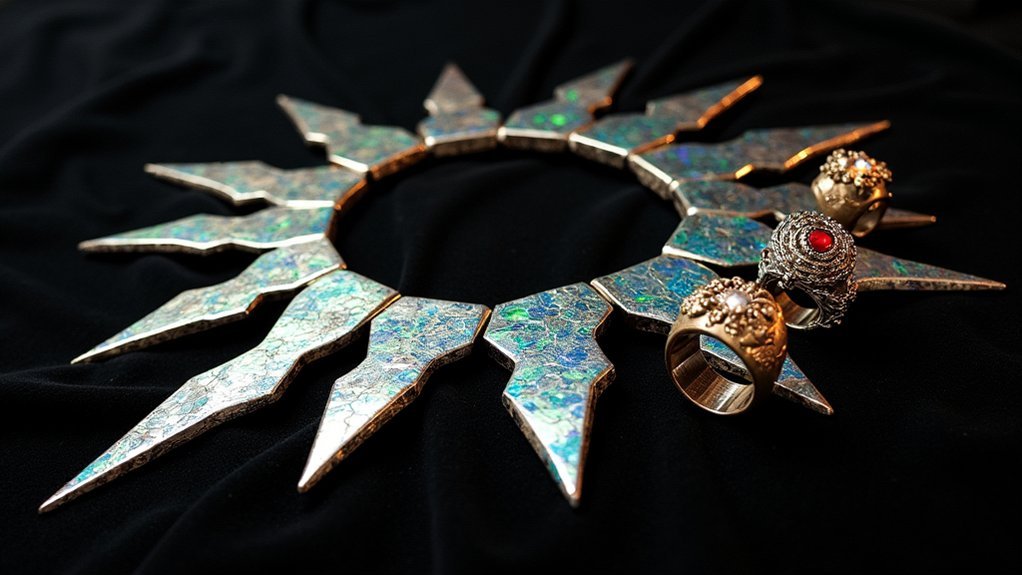
Revolution defines today’s avant-garde jewelry market, where designers abandon traditional forms to create pieces that challenge your expectations of what jewelry can be.
You’ll discover avant-garde style through bold geometric patterns merged with organic forms, creating sculptural pieces that transcend conventional accessories.
When you explore this market, you’ll encounter unconventional materials that replace standard metals and stones.
Designers prioritize sustainable, ethically sourced components that enhance their creative narratives while minimizing environmental impact.
You’ll find interactive elements becoming increasingly popular, with kinetic features that transform static jewelry into dynamic art you can manipulate.
These pieces blur boundaries between fashion and fine art, appealing to collectors who value innovation over tradition.
Contemporary avant-garde jewelry reflects cultural movements while showcasing cutting-edge techniques.
Historical Movements That Shaped Modern Jewelry Design
When surrealism and constructivism swept through the art world in the early 20th century, jewelry designers seized these revolutionary movements to break free from centuries-old conventions.
These historical movements fundamentally transformed how you’d perceive jewelry, shifting it from mere ornamentation to wearable art.
Pioneering collaborations between Salvador Dalí and Elsa Schiaparelli exemplified this transformation, creating pieces that challenged traditional boundaries.
You’ll find that these avant-garde jewelry innovations introduced:
- Unconventional materials like plastics, fabrics, and industrial components
- Geometric forms influenced by modernist principles
- Interactive designs that engaged wearers differently
- Sustainable practices emphasizing responsibly sourced materials
Mid-20th century modernism further revolutionized design through minimalist aesthetics, replacing ornate Victorian styles with clean lines.
Today’s avant-garde jewelry continues evolving, incorporating technology and environmental consciousness while maintaining its rebellious spirit against conventional design rules.
Unconventional Materials Transforming Contemporary Pieces
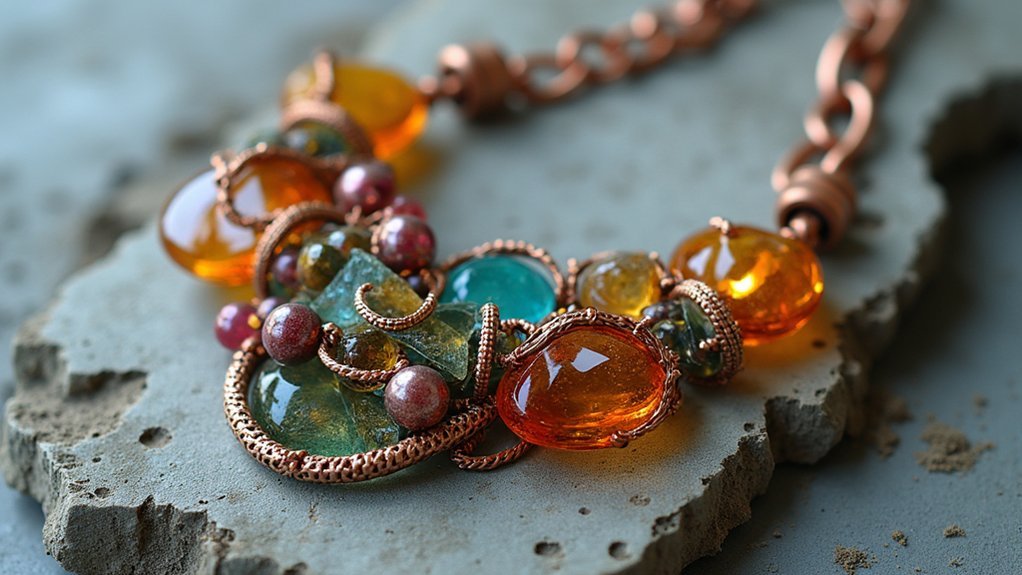
You’ll discover that avant-garde jewelry designers are revolutionizing the industry by embracing synthetic fabrics, rubber, and polymers that create textures impossible with traditional metals and gems.
These unconventional choices blend seamlessly with natural elements like ethically sourced stones, creating pieces that merge organic beauty with industrial innovation.
You’re witnessing a transformation where materials once considered unsuitable for jewelry now define the cutting edge of wearable art.
Synthetic Materials Revolution
As contemporary jewelry designers push creative boundaries, they’re embracing synthetic materials like polymers and resins to craft pieces that would be impossible with traditional metals and gemstones.
You’ll discover that avant-garde jewelry now blurs artistic boundaries through innovative textures and vibrant colors that challenge conventional design principles.
These revolutionary materials enable designers to create:
- Dynamic, kinetic jewelry with moving elements that respond to your body’s motion
- Sustainable pieces using ethically sourced synthetics that reduce environmental impact
- Industrial-natural hybrid designs combining organic elements with modern aesthetics
- Interactive accessories that enhance your wearing experience through engagement
When you examine these cutting-edge pieces, you’ll notice how designers merge synthetic innovations with traditional craftsmanship techniques, resulting in unique creations that showcase contemporary jewelry’s limitless creative potential.
Natural Elements Integration
While synthetic materials have revolutionized avant-garde jewelry, contemporary designers are simultaneously embracing nature’s raw beauty by incorporating unconventional organic elements into their creations.
You’ll discover pieces featuring wood, stone, and biodegradable substances that merge seamlessly with traditional gemstones and metals. These unconventional materials challenge your perception of jewelry as purely precious, creating unique textures that tell environmental stories.
When you examine contemporary avant-garde pieces, you’ll notice designs mimicking floral motifs and geological patterns through innovative craftsmanship.
These natural elements don’t just enhance aesthetic appeal—they convey powerful messages about environmental consciousness and humanity’s relationship with nature.
You’re witnessing artists who use their craft to emphasize sustainability while showcasing the inherent natural beauty found in organic materials.
Industrial Aesthetic Appeal
Beyond organic materials, contemporary avant-garde jewelry designers are turning to industrial elements that redefine luxury through unconventional means.
You’ll discover that unconventional materials like industrial metals, plastic, rubber, and nylon create pieces that boldly challenge traditional aesthetics while maintaining exceptional durability for everyday wear.
The industrial aesthetic transforms modern jewelry through:
- Striking contrasts between synthetic materials and traditional gemstones
- Enhanced functionality that merges beauty with practical wearability
- Bold textures that capture contemporary design principles
- Sustainable practices utilizing recycled and responsibly sourced materials
Designers like Anton Kuzmin of CROSS ELEMENTS exemplify this movement, blending natural elements with industrial aesthetics.
You’re witnessing jewelry that doesn’t just accessorize—it makes statements about creativity, sustainability, and the evolution of luxury in our modern world.
Geometric Forms and Abstract Shapes in Wearable Art
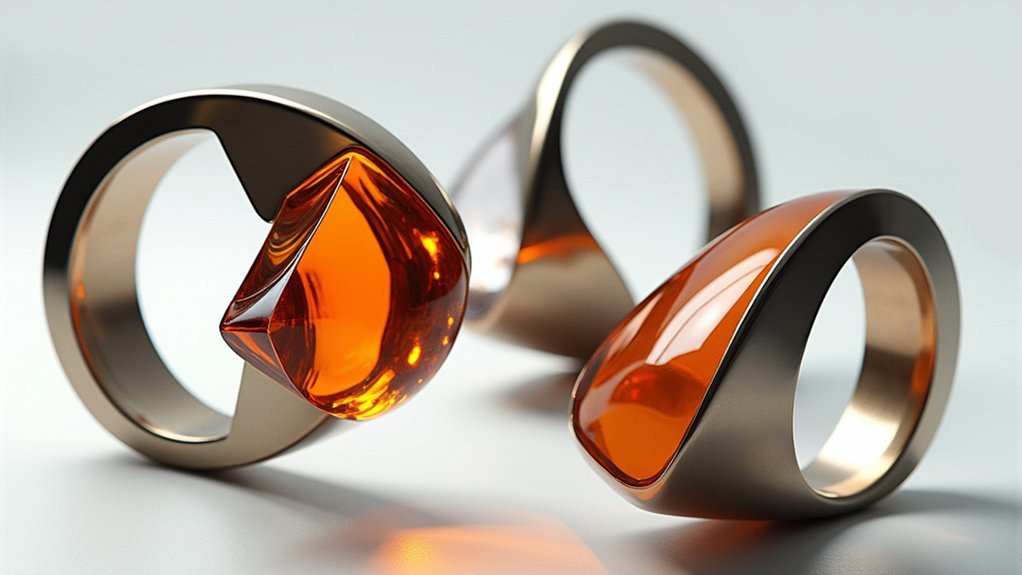
When you encounter avant-garde jewelry, you’ll immediately notice how geometric forms and abstract shapes transform traditional accessories into bold artistic statements.
These wearable art pieces challenge conventional designs through striking asymmetry and bold angles that create dynamic visual impact.
You’ll find designers experimenting with diverse materials like metal, acrylic, and fabric to enhance unique textures and contours.
This material innovation creates fascinating interplays of light and shadow that shift as you move.
Abstract shapes enable conceptual storytelling, allowing pieces to evoke emotions beyond mere ornamentation.
Contemporary trends include kinetic elements that respond to your motion, adding interactive dimensions.
Iconic designers like Parts of Four and Goti exemplify how geometric forms blur boundaries between jewelry and sculpture, creating truly innovative wearable art.
The Role of Sculptural Elements in Jewelry Creation
As sculptural elements take center stage in avant-garde jewelry, you’ll discover how designers transform precious metals and unconventional materials into three-dimensional narratives that exist somewhere between personal adornment and fine art.
These pieces challenge traditional jewelry conventions by prioritizing form and artistic expression over conventional functionality.
You’ll find that avant-garde creators push boundaries through:
- Organic shapes and bold geometries that blur sculpture-jewelry distinctions
- Unconventional materials like plastics, fabrics, and metals creating unique textures
- Kinetic features enabling movement and dynamic interaction
- Narrative-driven designs conveying cultural or personal stories
When you encounter these sculptural elements, you’re experiencing wearable art that transforms the body into a canvas for creative experimentation, where each piece becomes a statement of artistic vision.
Breaking Away From Traditional Gemstone Settings
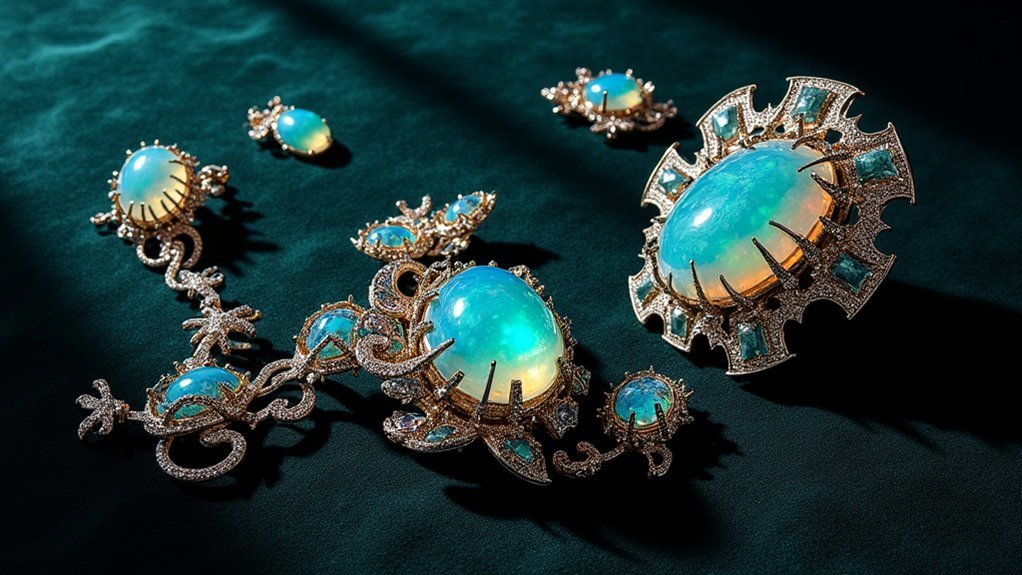
While traditional jewelry confines gemstones within predictable prong or bezel settings, avant-garde designers liberate these precious materials through radical reimagining of their presentation.
You’ll discover unconventional settings that embrace asymmetrical arrangements and abstract compositions, challenging symmetry’s dominance in classical design. These innovative approaches highlight each stone’s unique characteristics rather than following standardized mounting techniques.
You’ll find avant-garde jewelry combining gemstones with unexpected materials like resin, metal, and fabric, creating striking contrasts that redefine perception.
Designers prioritize storytelling over mere functionality, crafting settings that reflect personal narratives and conceptual themes.
Interactive elements add dynamic engagement—movable parts and kinetic features allow stones to respond to your movements and surroundings, transforming static jewelry into living art that evolves with wear.
Innovative Techniques Challenging Conventional Craftsmanship
Revolutionary fabrication methods transform how you’ll experience jewelry creation, with designers abandoning hammer-and-anvil traditions for cutting-edge technologies that redefine what’s possible.
3D printing enables intricate lattice structures and impossible geometries that would challenge even master craftsmen, while CAD software allows precise manipulation of mathematical forms into wearable sculptures.
These innovative techniques merge seamlessly with traditional craftsmanship:
- Hand-engraving techniques combine with laser cutting for unprecedented precision
- Enameling processes incorporate digital color mapping and controlled heating
- Stone setting adapts to unconventional materials like plastics and textiles
- Kinetic mechanisms integrate micro-engineering with artisanal assembly methods
You’ll witness avant-garde pieces that transform jewelry into dynamic art, where movement becomes integral to design.
This fusion challenges artisans to master both ancient skills and contemporary innovations, creating experiences that respond to your environment while maintaining exquisite craftsmanship standards.
Sustainability and Ethical Practices in Avant-Garde Design
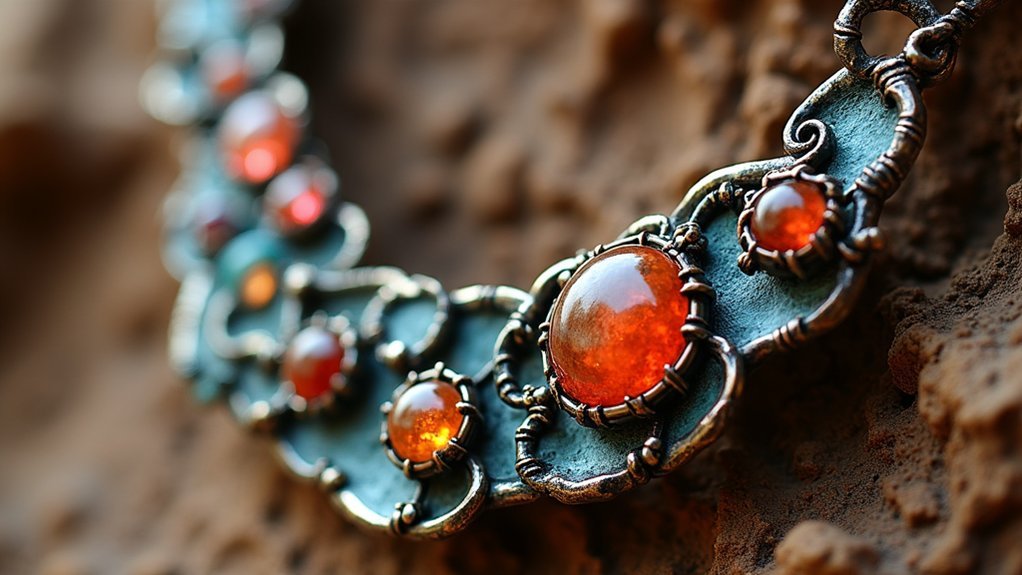
You’ll find that avant-garde jewelry designers are revolutionizing their craft by prioritizing ethically sourced materials, from responsibly mined gemstones to recycled metals that reduce environmental impact.
These innovative creators don’t just focus on aesthetics—they’re implementing eco-friendly production methods that incorporate alternative materials like reclaimed wood and bio-resins.
You can support responsible artisan practices by choosing designers who maintain transparent supply chains and collaborate with environmental advocacy organizations to promote industry-wide accountability.
Ethically Sourced Materials
As environmental consciousness reshapes the luxury market, avant-garde jewelry designers are revolutionizing their craft by prioritizing ethically sourced materials that don’t compromise artistic vision.
You’ll find these innovative creators ensuring their gemstones and metals come from suppliers who don’t exploit workers or damage ecosystems.
When you explore avant-garde jewelry today, you’re supporting designers who’ve embraced:
- Conflict-free diamonds and responsibly mined gemstones that maintain ethical standards
- Recycled materials that reduce industry waste while creating stunning pieces
- Lab-grown diamonds and sustainable metals offering eco-friendly alternatives
- Complete transparency in sourcing methods and production processes
You’ll discover that these designers openly share their practices, empowering you to make informed purchasing decisions.
This commitment demonstrates how avant-garde jewelry can be both artistically groundbreaking and ethically responsible.
Eco-Friendly Production Methods
Beyond sourcing ethical materials, avant-garde jewelry designers are transforming their workshops into sustainable production environments that reflect their environmental values.
You’ll find these creators embracing zero-waste philosophies, generating minimal scrap while repurposing leftover materials into innovative new pieces. They’re utilizing responsibly sourced materials including ethically mined gemstones and recycled metals that don’t contribute to environmental degradation or exploitative labor practices.
You’ll also discover designers experimenting with alternative materials like reclaimed wood, natural fibers, and biodegradable polymers that offer unique aesthetics while reducing waste.
As consumer demand for sustainable fashion grows, these avant-garde brands increasingly highlight their commitment to ethical practices, appealing to conscious audiences seeking both artistry and responsibility in their luxury purchases.
Responsible Artisan Practices
The artisans themselves represent the heart of sustainable avant-garde jewelry, where individual craftspeople implement responsible practices that extend far beyond material choices into their daily work rhythms and community engagement.
You’ll find these creators building partnerships with ethical suppliers who share their commitment to environmental stewardship and fair labor practices.
Their dedication to sustainable practices manifests through:
- Adopting low-impact manufacturing techniques that minimize energy consumption
- Collaborating with organizations focused on environmental advocacy
- Ensuring complete supply chain transparency for consumer trust
- Supporting local communities through responsible sourcing partnerships
When you choose avant-garde pieces from these artisans, you’re supporting craftspeople who’ve transformed their workshops into models of sustainability, proving that innovative design and environmental responsibility can coexist harmoniously.
Interactive and Kinetic Features in Modern Jewelry
While traditional jewelry remains static on the body, interactive and kinetic pieces transform the very relationship between wearer and ornament. You’ll discover these avant-garde designs incorporate swivels, hinges, and movable parts that invite your touch and engagement.
When you wear kinetic jewelry, you’re not just displaying decoration—you’re participating in an evolving sculptural experience.
These innovative pieces challenge conventional functionality by offering multiple transformations. You can change their shape or function throughout the day, creating different looks that reflect your mood and creativity.
Modern technology amplifies this concept further, with digital elements responding to your movements and surroundings. This interactive approach emphasizes aesthetic and experiential aspects over mere ornamentation, encouraging you to express your personality through dynamic, ever-changing wearable art that blurs boundaries between jewelry and sculpture.
Cultural Influences on Contemporary Design Aesthetics
Although avant-garde jewelry breaks conventional boundaries, it draws profound inspiration from diverse cultural art movements that shape its revolutionary aesthetics.
You’ll discover how constructivism and surrealism influence contemporary designers who boldly reinterpret traditional craftsmanship through modern lenses.
Cultural influences manifest in several key ways:
- Material Innovation: You’ll find fabrics and polymers creating unique textures that blend heritage with contemporary trends.
- Motif Reinterpretation: Traditional symbols receive fresh avant-garde treatments that honor origins while pushing boundaries.
- Narrative Integration: Historical contexts become embedded storytelling elements within each piece.
- Sustainable Practices: Ethical material sourcing reflects cultural shifts toward responsible design.
You’ll appreciate how these pieces transcend mere ornamentation, becoming cultural artifacts that celebrate diversity while challenging conventional jewelry norms through innovative forms and meaningful narratives.
The Fusion of Technology and Traditional Metalwork
You’re witnessing a remarkable transformation where ancient metalworking traditions merge seamlessly with cutting-edge digital tools.
CAD software now works alongside hand-engraving techniques, allowing you to achieve both precise measurements and authentic artistic expression in your designs.
This digital revolution hasn’t replaced traditional craftsmanship—it’s enhanced it, giving you unprecedented creative freedom to push beyond conventional jewelry boundaries.
Digital Design Revolution
As digital technology reshapes creative industries worldwide, avant-garde jewelry design stands at the forefront of an unprecedented revolution that’s fundamentally transforming how artisans conceptualize and craft wearable art.
You’re witnessing a paradigm shift where Computer-Aided Design software enables precise measurements and intricate visualizations that amplify creative boundaries.
Digital design tools now empower you to:
- Experiment with complex geometries through rapid prototyping
- Create unconventional forms that challenge traditional norms
- Utilize 3D printing for intricate designs impossible through conventional methods
- Customize bespoke pieces tailored to individual preferences
This technological integration streamlines production while preserving artisanal craftsmanship.
You’re experiencing how avant-garde jewelry designers blend traditional metalwork with digital fabrication techniques, producing dynamic pieces that redefine wearable art’s possibilities and push creative expression beyond conventional limitations.
Handcraft Meets Innovation
While cutting-edge software opens new creative frontiers, the heart of avant-garde jewelry remains anchored in masterful handcraft techniques that breathe life into digital concepts.
You’ll witness skilled artisans transforming your innovative designs into tangible masterpieces through intricate hand-engraving, stone setting, and metalworking that challenges conventional norms.
This fusion demands meticulous attention to detail as craftspeople select fine gemstones, precious metals, and alternative materials to create extraordinary textures and aesthetics.
You’re part of an iterative process where traditional techniques merge with modern innovation, encouraging exploration of new materials and methods.
Quality control guarantees your pieces maintain exceptional durability and aesthetic appeal while adhering to ethical sourcing standards, resulting in functional art that embodies true avant-garde principles.
Notable Avant-Garde Jewelry Designers and Their Impact
Visionaries in avant-garde jewelry design have transformed how we perceive wearable art, challenging conventional boundaries between craft and conceptual expression.
These jewelry designers push creative limits while honoring traditional techniques, creating pieces that blur the lines between ancient craftsmanship and contemporary innovation.
Leading avant-garde jewelry creators include:
- Klaus Lohmeyer of Werkstatt:München crafts unisex silver and gold pieces emphasizing handmade techniques with avant-garde aesthetics.
- Anton Kuzmin’s CROSS ELEMENTS merges natural materials with industrial designs, creating distinctive pieces like the Bent Nail Pendant.
- Evan Sugerman’s Parts of Four explores rituals and memories through thought-provoking forms and materials.
- Chin Teo combines traditional silversmithing with medieval-inspired contemporary designs from his Berlin workshop.
These artists demonstrate how avant-garde jewelry transcends mere ornamentation, becoming wearable philosophy that questions conventional design principles.
Collecting and Caring for Statement Art Jewelry
When you’re considering avant-garde jewelry as an investment, you’ll need to evaluate each piece’s artistic merit, designer reputation, and market demand potential.
You’ll want to store your statement pieces in individual soft pouches or lined compartments to prevent scratching and maintain their unique finishes.
You should establish relationships with specialized conservators who understand unconventional materials and techniques used in art jewelry construction.
Investment Value Assessment
Beyond their artistic merit, avant-garde jewelry pieces represent compelling investment opportunities that combine aesthetic pleasure with financial potential.
You’ll discover that these pieces often appreciate considerably over time due to their historical importance and unique craftsmanship that sets them apart from mass-produced alternatives.
When evaluating investment value, consider these critical factors:
- Provenance and storytelling – Each piece’s narrative enhances market appeal
- Artisan reputation – Established creators command higher values
- Material quality – Premium metals and stones guarantee durability
- Ethical sourcing – Sustainable practices increase collector desirability
You’re investing in wearable art that speaks to responsible consumerism trends.
The combination of artistic innovation, limited availability, and growing appreciation for handcrafted excellence makes avant-garde jewelry increasingly attractive to discerning collectors seeking both beauty and financial returns.
Proper Storage Methods
The longevity of your avant-garde jewelry collection depends entirely on how you store and handle these delicate artistic creations.
Proper storage methods for avant-garde jewelry require individual pouches or compartments to prevent tangling and friction damage, particularly for thin chains and intricate designs. You’ll want to wipe each piece with a soft, lint-free cloth after wearing to remove skin oils and maintain their lustrous finish.
Keep your collection away from moisture and humidity, which can tarnish metals and compromise delicate craftsmanship.
Inspect pieces regularly for loose stones, damaged clasps, or structural weaknesses that need immediate attention.
For highly ornate or complex avant-garde jewelry, schedule professional cleaning every few years to preserve their artistic integrity and unique design elements.
Professional Maintenance Guidelines
Although proper storage forms the foundation of jewelry care, professional maintenance requires a more nuanced approach that goes beyond basic handling techniques.
You’ll need to develop systematic inspection habits and cleaning protocols to maintain the original condition of your avant-garde pieces.
Essential maintenance practices include:
- Regular inspections – Examine intricate components for wear, loose settings, or structural damage that could compromise the piece’s integrity.
- Gentle cleaning methods – Use mild soap and soft brushes for routine maintenance, avoiding harsh chemicals that damage delicate finishes.
- Moisture protection – Remove jewelry before showering, swimming, or exposure to humidity to prevent tarnishing and material degradation.
- Professional cleaning – Schedule expert servicing for complex designs and valuable pieces requiring specialized care techniques.
Future Trends in Experimental Jewelry Design
How will experimental jewelry designers reshape the landscape of wearable art in the coming years? You’ll witness a revolutionary shift toward sustainability as designers embrace responsibly sourced materials and eco-friendly production methods. They’re merging unconventional materials like textiles and synthetic polymers with traditional metals, creating unprecedented textures and forms.
| Technology Integration | Design Elements | Material Innovation |
|---|---|---|
| 3D printing capabilities | Bold geometric shapes | Sustainable sourcing |
| Augmented reality features | Asymmetrical patterns | Textile combinations |
| Interactive kinetic elements | Sculptural interpretations | Synthetic polymers |
You’ll experience jewelry that responds to your touch through kinetic elements and dynamic features. Advanced technologies like 3D printing enable intricate customization while augmented reality transforms how you interact with pieces. Expect bold geometric shapes and asymmetrical patterns that transform accessories into sculptural art forms.
Frequently Asked Questions
What Does Avant-Garde Mean in Jewelry?
You’ll find avant-garde jewelry challenges conventional design rules through innovative materials, bold forms, and artistic expression. It’s wearable art that breaks boundaries, incorporating unconventional elements to create unique pieces that blur jewelry and art distinctions.
Are Jewelry Designs Copyrighted?
You can copyright jewelry designs if they’re original and fixed in tangible form like sketches or photos. Copyright protects the artistic expression but doesn’t cover functional aspects or underlying ideas of your pieces.
What Does Avant-Garde Mean in Design?
You’re exploring experimental design that challenges conventional rules and pushes creative boundaries. It’s innovative work that prioritizes artistic expression over commercial appeal, using unconventional materials and bold concepts to create groundbreaking aesthetics.
How Can I Protect My Jewelry Design?
You’ll protect your jewelry design by applying for trademarks, using copyright laws, keeping detailed design records, implementing NDAs with collaborators, and actively monitoring the market for infringements to maintain your brand’s integrity.
In Summary
You’re witnessing jewelry’s evolution into pure artistic expression. You’ll find that avant-garde pieces challenge everything you thought you knew about wearable art. Whether you’re collecting bold geometric forms or experimenting with unconventional materials, you’re participating in a movement that’s reshaping how we define jewelry. Don’t hesitate to embrace these boundary-pushing designs—you’ll discover that breaking traditional rules opens endless possibilities for personal expression and artistic discovery.

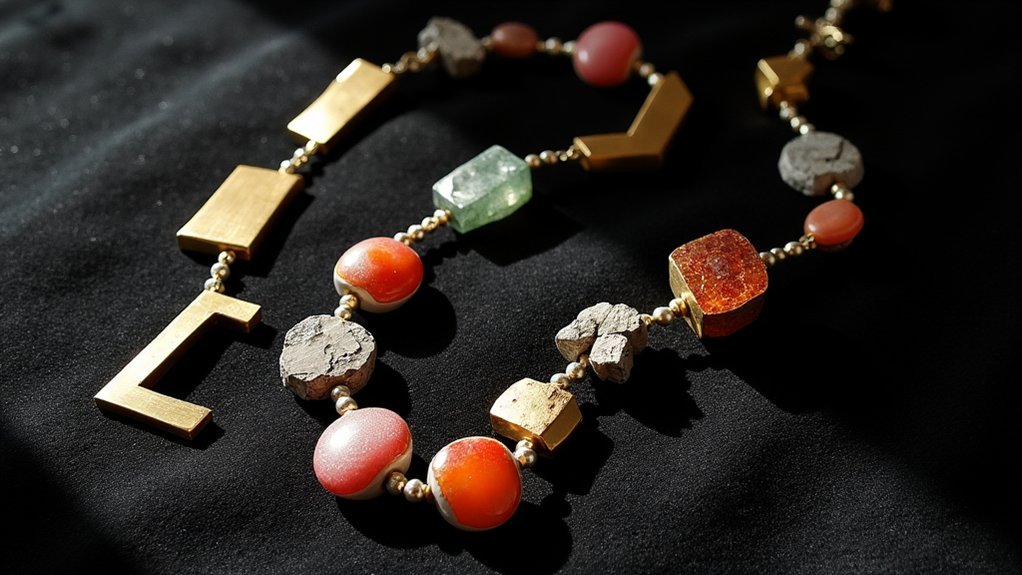
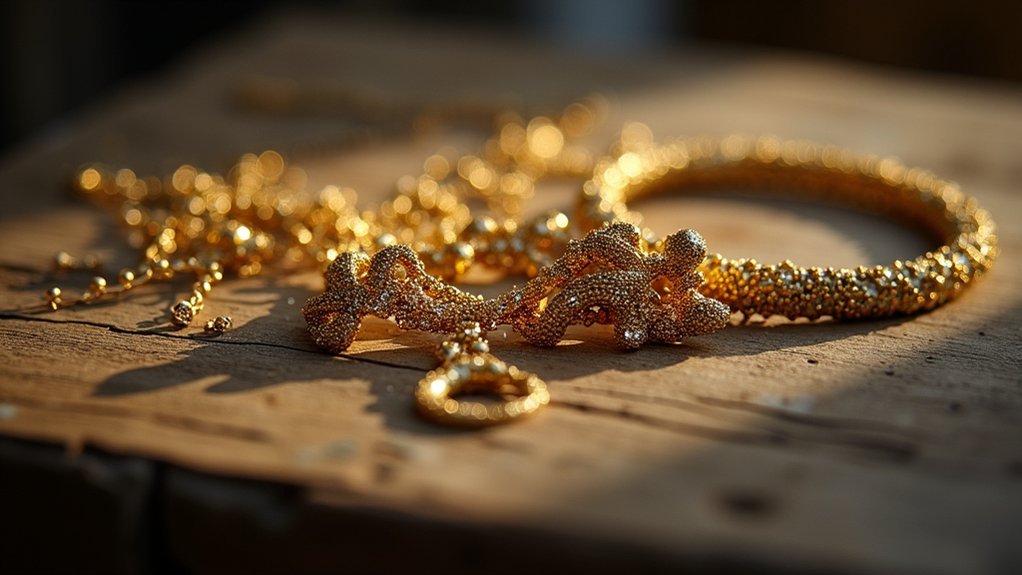
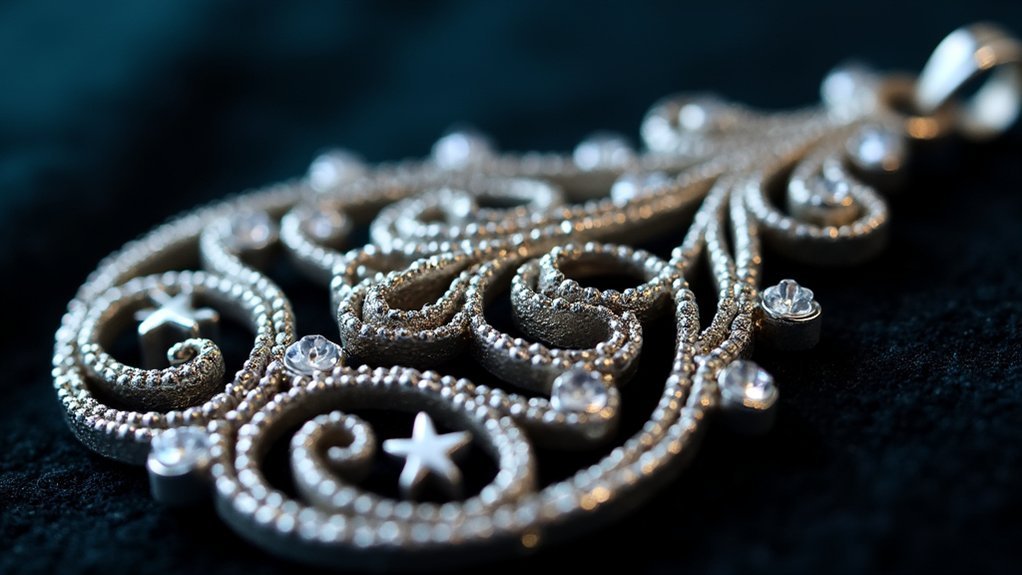
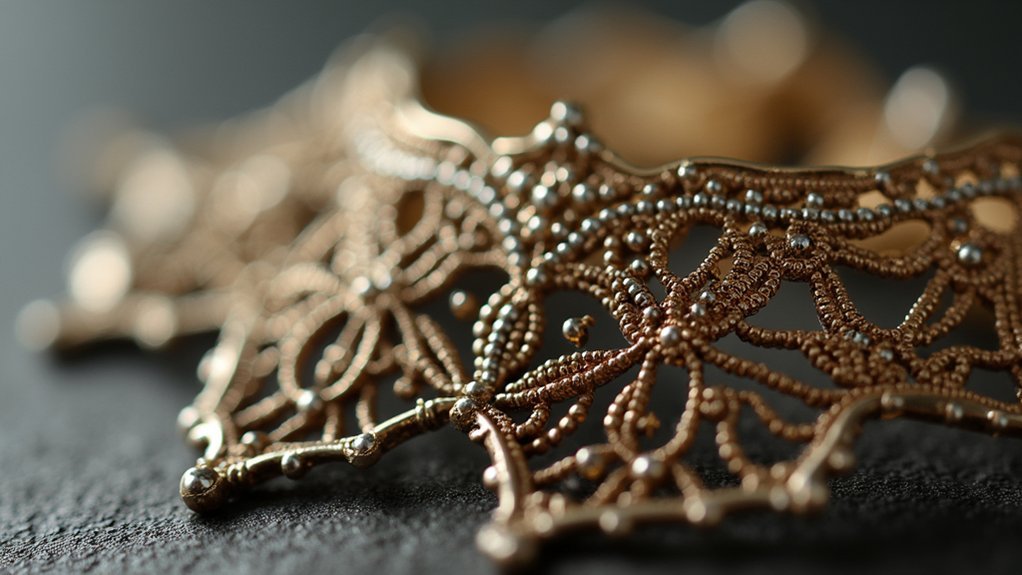
Leave a Reply